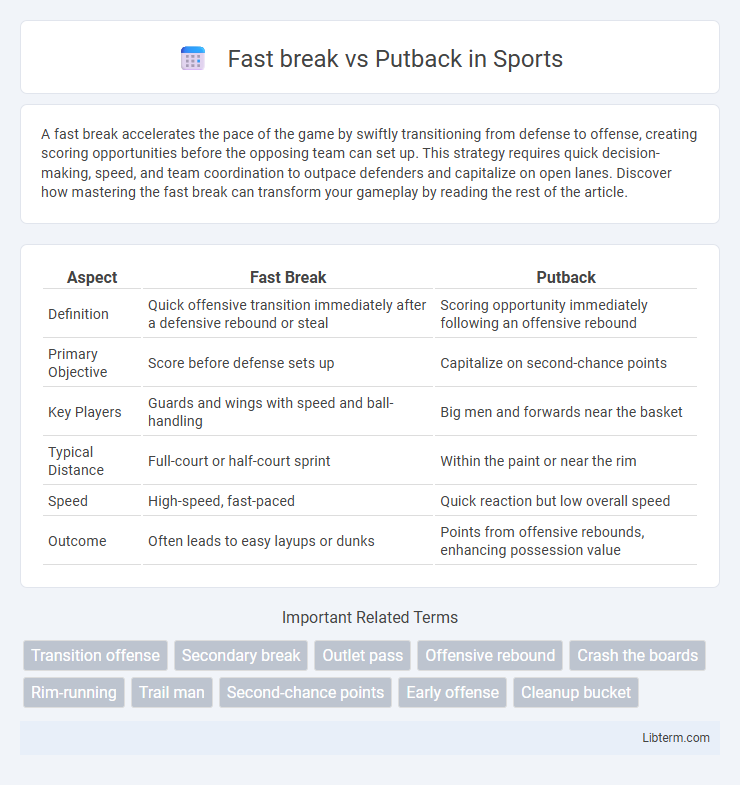A fast break accelerates the pace of the game by swiftly transitioning from defense to offense, creating scoring opportunities before the opposing team can set up. This strategy requires quick decision-making, speed, and team coordination to outpace defenders and capitalize on open lanes. Discover how mastering the fast break can transform your gameplay by reading the rest of the article.
Table of Comparison
| Aspect | Fast Break | Putback |
|---|---|---|
| Definition | Quick offensive transition immediately after a defensive rebound or steal | Scoring opportunity immediately following an offensive rebound |
| Primary Objective | Score before defense sets up | Capitalize on second-chance points |
| Key Players | Guards and wings with speed and ball-handling | Big men and forwards near the basket |
| Typical Distance | Full-court or half-court sprint | Within the paint or near the rim |
| Speed | High-speed, fast-paced | Quick reaction but low overall speed |
| Outcome | Often leads to easy layups or dunks | Points from offensive rebounds, enhancing possession value |
Understanding Fast Breaks in Basketball
A fast break in basketball is a rapid transition from defense to offense aimed at scoring quickly before the opposing defense sets up, typically involving a quick outlet pass and sprinting players. This strategy maximizes scoring opportunities by exploiting numerical advantages and defensive disorganization. Unlike putbacks, which occur after an offensive rebound near the basket, fast breaks rely on speed and court vision to generate open shots or easy baskets in transition.
What Is a Putback? Key Concepts
A putback in basketball refers to an immediate shot attempt made by an offensive player after securing an offensive rebound, often occurring close to the basket. Unlike a fast break, which involves quick transition scoring opportunities after a defensive stop, a putback capitalizes on a second chance within the same possession. Key concepts include timing, positioning near the rim, and quick decision-making to convert missed shots into points efficiently.
Fast Break: Core Principles and Execution
Fast break in basketball emphasizes quick transition offense to capitalize on defensive disarray, enabling teams to score efficiently before opponents set up. Core principles include rapid outlet passing, aggressive ball handling, and strategic spacing to create open lanes or high-percentage shots. Effective execution depends on players' speed, court awareness, and seamless coordination to maintain momentum and exploit numerical advantages.
Putback: Techniques and Timing
Putbacks require precise timing and strong positioning to capitalize on missed shots, converting rebounds into immediate scoring opportunities. Effective putback techniques include quick elevation, proper hand placement for control, and anticipation of ball trajectory off the rim or backboard. Mastering these skills enhances offensive efficiency by maximizing second-chance points through aggressive floor awareness and rapid decision-making.
Offensive Advantages: Fast Break vs Putback
Fast breaks create immediate scoring opportunities by exploiting defensive mismatches and open lanes, increasing the pace and pressure on opponents. Putbacks leverage offensive rebounds to convert missed shots into quick second-chance points, capitalizing on proximity to the basket. Both strategies enhance offensive efficiency, but fast breaks generate high-percentage shots in transition, while putbacks focus on maximizing possession value near the rim.
Defensive Strategies Against Fast Breaks
Defensive strategies against fast breaks emphasize quick transition and communication to prevent easy scoring opportunities by the offense. Key tactics include sprinting back on defense, maintaining discipline to avoid unnecessary fouls, and positioning defenders to intercept passes or force contested shots. Effective fast break defense relies on coordinated efforts to slow the ball, protect the paint, and secure defensive rebounds to limit putback chances.
Countering Putbacks: Rebounding Tactics
Countering putbacks in basketball requires aggressive box-out techniques and anticipation of the offense's scoring rebound. Utilizing fast break opportunities hinges on securing defensive rebounds quickly and initiating rapid transition plays before opponents reset. Effective rebounding tactics combine positioning, timing, and quick outlet passes to limit second-chance points and fuel fast breaks.
Key Players Specializing in Fast Breaks and Putbacks
Key players specializing in fast breaks, such as LeBron James and Russell Westbrook, excel at exploiting transition opportunities with speed and court vision to score quickly before the defense sets up. In contrast, dominant putback specialists like Andre Drummond and DeAndre Jordan capitalize on offensive rebounds to secure second-chance points through powerful dunks or tip-ins near the basket. Both fast breaks and putbacks are crucial offensive strategies, with elite players maximizing scoring efficiency by taking advantage of tempo and positioning.
When to Use: Situational Analysis
Fast breaks are most effective during transitions when the defense is disorganized and players can quickly advance the ball before the opposing team sets up. Use putbacks in aggressive rebounding scenarios, especially after an offensive rebound near the basket, to capitalize on second-chance scoring opportunities. Situational analysis emphasizes fast breaks for speed and spacing, while putbacks leverage positioning and timing under the rim.
Impact on Game Momentum: Fast Breaks vs Putbacks
Fast breaks generate rapid scoring opportunities by exploiting defensive gaps, significantly shifting game momentum through quick transitions and crowd energizing plays. Putbacks capitalize on offensive rebounds, maintaining possession and applying immediate pressure on opponents, sustaining momentum in half-court scenarios. The dynamic nature of fast breaks often ignites faster tempo, while putbacks solidify momentum by reinforcing physicality and control inside the paint.
Fast break Infographic

 libterm.com
libterm.com